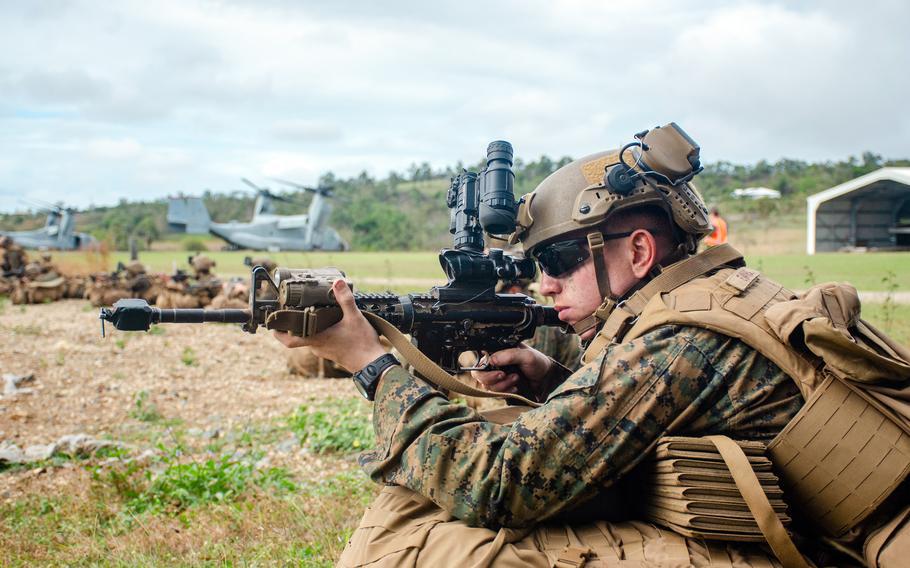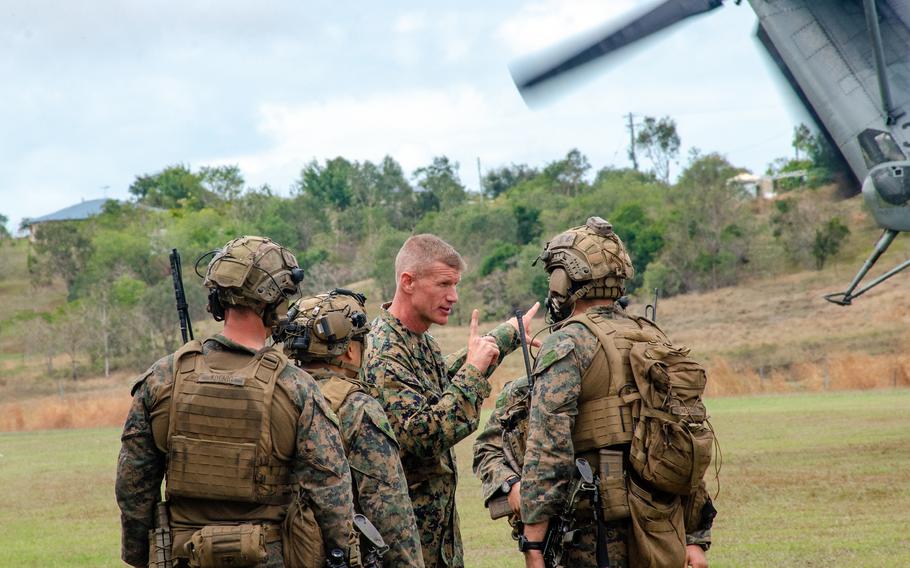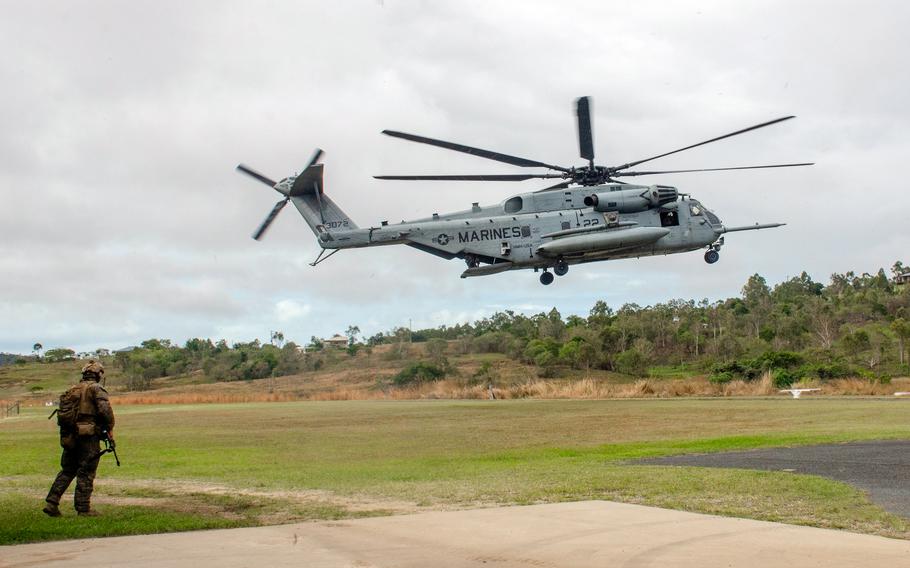BLOOMSBURY AIRFIELD, Australia — Dozens of U.S. Marines piled in and out of aircraft on this remote, privately owned airfield Friday as part of ongoing training to hone their ability to fight in the Indo-Pacific.
Six MV-22 Ospreys landed on the airfield that U.S. and Australian forces have contracted for use during Talisman Sabre, a massive, biennial exercise with 30,000 troops in eastern Australia.
More than 100 members of 3rd Battalion, 1st Marines out of Camp Pendleton, Calif., came in on the tiltrotors, according to Master Sgt. Enrique Mendoza, weapons company operations chief for the battalion.

A U.S. Marine posts security during an uncontested air-assault exercise at Bloomsbury Airfield in Midge Point, Australia, Friday, June 28, 2023. (Jennessa Davey/Stars and Stripes)
They relieved a contingent from 2nd Battalion, 1st Marines, also from Pendleton, after 2nd Battalion captured the airfield from opposing forces two days earlier. Their practice assault was part of a Talisman Sabre force-on-force exercise by troops from the U.S., Australia and eight other nations operating across 17,000 square miles.
“You’re seeing us try to exercise some of our expeditionary advanced base operations that are unique to the theater which we are operating in, which is inherently maritime and includes long distances at sea,” Brig. Gen. Kevin Jarrard, assistant commander of the 1st Marine Division, told reporters at the airfield.
Around 15 minutes after the 3rd Battalion arrived, two CH-53 Sea Stallions landed on the airfield to take the 2nd Battalion back to the amphibious assault ship USS America somewhere offshore. The remaining troops would secure the area and establish spots for artillery deployment of artillery, Mendoza said.
The drill gave the two battalions, as well as other Marine units engaged in the larger force-on-force exercise based out of Townsville about 184 miles north along the coast, a chance to practice their skills in a low-stakes but real-world scenario, Jarrard said.
“We’re moving and removing Marines at long distances, simulating a contested logistical environment, which will cause us to try and solve some problems that we haven’t really had to solve in a long time,” he said.
Landing and extracting troops is a routine task, but the Marines involved in Talisman Sabre also focus on integrating with allied forces and experimenting with new technologies.

Brig. Gen. Kevin Jarrard, assistant commander of the 1st Marine Division, coaches his Marines during an uncontested air-assault exercise at Bloomsbury Airfield in Midge Point, Australia, Friday, June 28, 2023. (Jennessa Davey/Stars and Stripes)
“The coalition nature of the exercise is helpful, and whenever we talk about joint and coalition warfare, it’s all the ‘inter’ words – ‘interoperability,’ and what we think is even a more mature view is ‘interchangeable,’” Jarrard said. “So, you can take units, allies and partners and interchange them and still get the same degree, or similar degrees, of proficiency and execution.”
The U.S. military uses “interoperability” to describe the ability of a country’s armed forces to use another country’s training methods and military equipment.
New technology that Jarrard said he is excited about are autonomous unmanned ground vehicles. Still in the experimentation phase, they could be used soon to transport supplies or even casualties in a contested environment, he said.

A U.S. Marine Corps CH-53 Super Stallion lands during an uncontested air-assault exercise at Blomnsbury Airfield in Midge Point, Australia, Friday, June 28, 2023. (Jennessa Davey/Stars and Stripes)
“If I can tell a machine to deliver something for me and not have to put Marines at risk to do that, that’s very attractive to me,” he said. “As a commander, I have to think about the risk to force.”
The Marines are also drawing on lessons learned from the battles being fought in Ukraine, including how to hide troops, buildings and other assets through traditional camouflage and masking electronic signatures.
“When we talk about war, we generally like to remind everybody that the nature of war is unchanging, but the character of war is ever-changing,” he said.